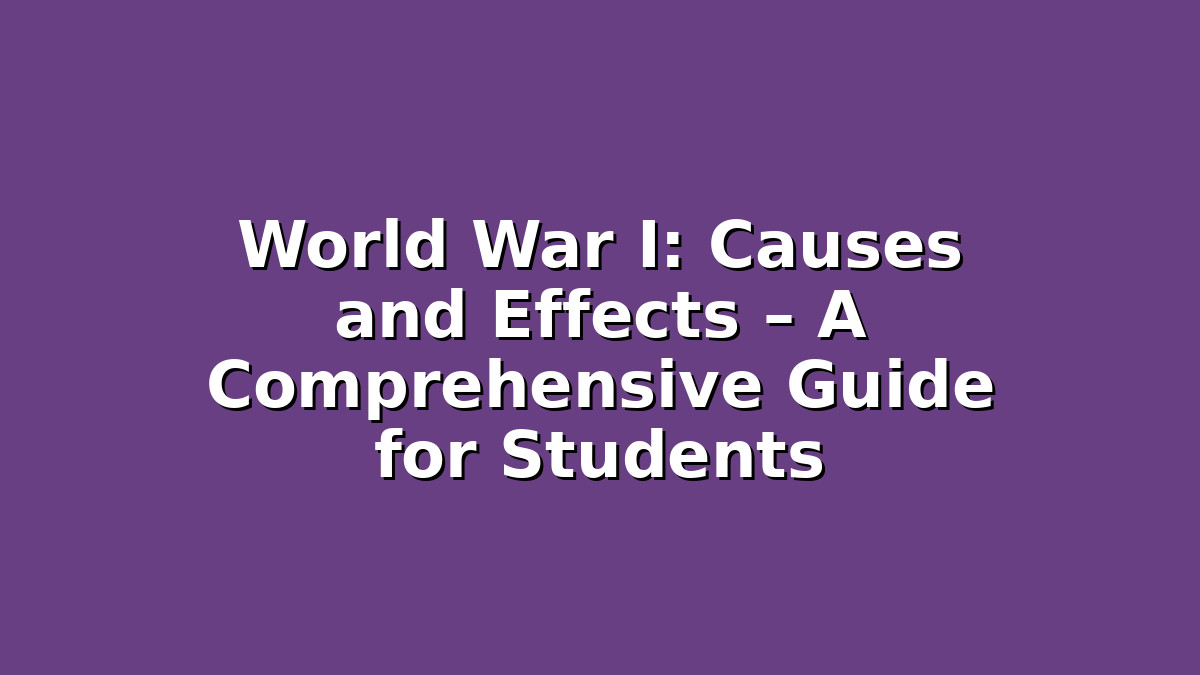Studying for exams can sometimes feel overwhelming, especially when tackling complex historical events like World War I. Understanding the causes and effects of this global conflict is not only crucial for your exams but also helps you gain a broader perspective on how history shapes the present. In this article, we’ll break down the key causes and effects of World War I, along with practical study tips to help you master the topic efficiently. Let’s dive in!
Introduction
World War I, also known as the Great War, was one of the deadliest conflicts in history, lasting from 1914 to 1918. It involved many of the world’s major powers and dramatically changed political boundaries, societies, and international relations. For students, World War I is a vital subject in history curriculums worldwide. Understanding why it started and how it impacted the world can be challenging, but with the right approach, you can confidently tackle this topic in your exams.
Section 1: Causes of World War I – Understanding the Root Factors
World War I did not start overnight. It was the result of several long-term and immediate causes that created a tense and unstable environment in Europe.
Main Causes:
– Militarism: Leading European nations were engaged in an arms race, building massive armies and navies. Countries believed that having a strong military would protect their interests and deter enemies.
– Alliances: Europe was divided into two main alliance systems – the Triple Alliance (Germany, Austria-Hungary, Italy) and the Triple Entente (France, Russia, Great Britain). These alliances meant that a conflict involving one country could quickly involve others.
– Imperialism: Competition for colonies and global dominance increased tensions, especially between Britain, France, and Germany.
– Nationalism: Intense pride and loyalty to one’s nation often fostered rivalries and ethnic tensions, particularly in the Balkans.
– The Spark – Assassination of Archduke Franz Ferdinand: The immediate trigger was the assassination of the heir to the Austro-Hungarian throne in June 1914 by a Serbian nationalist. This event set off a chain reaction of declarations of war.
Study Tip:
Create a cause-and-effect timeline or mind map to visualize how these factors interconnect. Breaking down complex information into diagrams helps memory retention and makes revision more engaging.
Section 2: Effects of World War I – The Aftermath and Global Impact
The effects of World War I were vast and reshaped the world politically, socially, and economically.
Key Effects:
– Political Changes: The war led to the collapse of empires—Austro-Hungarian, Ottoman, Russian, and German—and the rise of new countries in Europe. The Treaty of Versailles in 1919 officially ended the war but imposed heavy reparations on Germany, sowing the seeds for World War II.
– Social Impact: Millions of soldiers and civilians died or were injured. The war also led to significant social changes, including shifts in gender roles as women took on jobs traditionally held by men.
– Economic Consequences: Many European economies were devastated, leading to inflation, debt, and unemployment. The U.S. emerged as a major economic power.
– Technological Advances: The war accelerated technology in warfare and medicine, influencing future conflicts.
– League of Nations: Created to promote peace and prevent future wars, though it ultimately failed to stop World War II.
Study Tip:
Summarize each effect with bullet points and relate them to modern-day consequences or events you are familiar with. Connecting history to current events boosts understanding and helps you remember facts better.
Section 3: Study Strategies for Mastering World War I
To excel in exams, it’s important not just to memorize facts but to understand concepts and practice applying them.
Effective Study Strategies:
– Active Reading: While studying your textbook or notes, highlight key points and write questions in the margins. For example, “Why did militarism create tensions?” or “How did the Treaty of Versailles contribute to future conflicts?”
– Use Practice Questions: Test yourself with past exam questions or create flashcards with cause-effect pairs. This reinforces learning and identifies areas needing improvement.
– Group Study: Discussing the material with classmates can help clarify difficult concepts and expose you to different perspectives.
– Teach Someone Else: Explaining what you’ve learned to a friend or family member can solidify your understanding.
– Regular Revision: Break your study sessions into smaller chunks over several days or weeks. Repetition is key to long-term retention.
Study Tip:
Use the “Pomodoro Technique” – study for 25 minutes, then take a 5-minute break. This helps maintain focus and prevents burnout during long study sessions.
Conclusion
World War I is a significant topic that opens a window into the complexities of international relations and the consequences of global conflict. By understanding its causes and effects, you not only prepare for your exams but also develop critical thinking skills useful in many areas of study. Remember to use study tools like timelines, practice questions, and group discussions to make your revision more effective. Stay positive, and keep your study sessions organized – with consistent effort, you’ll master World War I and feel confident on exam day!
Good luck with your studies!

Responses